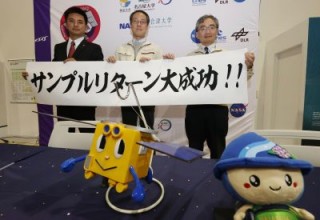Loading
Search
▼ Japan’s Space Defence Policy Charts Its Own Course
- Category:Other
If history is a guide, conflict in space may well be inevitable. The ‘New Space Race’ both reflects and affects the present era of great power competition. Today space is a militarised and increasingly weaponised landscape.
Present trends indicate that the world’s leading space powers possess kinetic and non-kinetic anti-satellite capabilities. China demonstrated this in 2007, the United States in 2008, India in 2019, and Russia in 2020.
The rise of dedicated military space units is one response by governments to protect space assets that underpin their commercial and military standings. At stake is unfettered access and freedom to operate in outer space, now widely seen as a warfighting domain in a larger geopolitical contest.
This is why leading powers such as the United States and China draw widespread attention when they move to establish military space forces, equip and train troops, preserve hardware or upgrade technologies.
But their less visible attempts to shape formal and informal alliances also deserve scrutiny. On one side are the United States, its commercial enterprises and its allies like NATO, Japan and Australia. On the other are China and its associates in the Asia Pacific Space Cooperation Organization (APSCO), its infrastructure investment partners from the Belt and Road Initiative that extends into space and its potential civil–military space partnership with Russia.
The influence of these two contending leaders — and peaceful prospects in outer space — are affected by which allies they are able to attract, persuade and manage.
The newly minted United States Space Force (USSF) recognises that space security requires strong partnerships at home and abroad. Japan is one partner that the United States is counting on in the event of space conflict.
Japan already has an advanced suite of counterspace capabilities that can both take on space debris and rival spacecraft disruptions to its assets. These include civilian and commercial space technologies such as the Hayabusa spacecraft, which has clear military uses. The Hayabusa-2 space probe was able to fire a ‘bullet’ into an asteroid to create a ‘bomb’ crater for collecting subsurface samples.
Japan launched the Space Operations Squadron (SOS) in May 2020. Its mandate is to secure and stabilise space by building platforms for space situation monitoring. This is necessary to counter threats to critical infrastructure posed by space debris and rival killer satellites. The SOS achieves this with the expanding cooperation between the Ministry of Defense and the Japan Aerospace Exploration Agency (JAXA).
The 2020 Defense of Japan Annual White Paper emphasises the need to continue acquiring offensive and defensive capabilities involving the space domain. Japanese leadership stresses the importance of protecting the country’s superiority in the space domain. Japan and six other countries have also signed on to the US-led 2020 Artemis Accords, signalling their national interests in the commercial recovery of space resources and governance on the moon, Mars, comets and asteroids.
While Japan is formally aligned with the United States, its broader geo-economics strategy is positioned very differently. It has ground up means to shape aspects of an expected trillion-dollar space economy.
And it is seeking out economic and diplomatic engagements with other players, including Europe, Australia, the United Arab Emirates, and the 52 participant countries of its Asia Pacific Regional Space Agency Forum (APRSAF).
Japan also has its own China initiatives, which represent a strategic challenge for any US–led space alliance. Japan has an eye on how China’s space ventures are embedded in its broader economic strategies in Asia and beyond.
China has successfully returned samples from the moon and become the first country to execute robotic rendezvous and docking in lunar orbit. It has planted a flag on the moon and has ambitions to set up a manned lunar station.
China heads APSCO, an intergovernmental organisation long seen as a rival to the Japan-led APRSAF. But APSCO has the means to build cooperative partnerships and China has sent delegations to APRSAF annual meetings.
These two organisations could well forge pragmatic scientific and economic collaborations. More likely, they may consider space infrastructure investment a means to facilitate economic development and poverty reduction across Asia.
While talk of space conflict is high, the prospects for alliance cohesion are sobering. The shaky bipolarity of alliances and growing complexities in space-oriented statecraft paint an uncertain picture of either the United States or China prevailing in future space conflicts.
In a modern geopolitical context, alliances are not as straightforward as they may appear. Japan is a clear example of this — its current behaviour complicates the picture of Japan as a perennial rival of China and a stalwart ally of the United States.
Competing interests and conflicting visions mean that in the modern space landscape, it is unwise — and unsafe — to take allies for granted.
- January 18, 2021
- Comment (0)
- Trackback(0)


